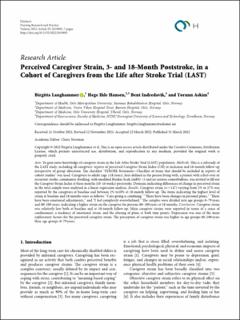| dc.contributor.author | Langhammer, Birgitta | |
| dc.contributor.author | Ihle-Hansen, Hege | |
| dc.contributor.author | Indredavik, Bent | |
| dc.contributor.author | Askim, Torunn | |
| dc.date.accessioned | 2023-03-09T11:59:22Z | |
| dc.date.available | 2023-03-09T11:59:22Z | |
| dc.date.created | 2022-01-18T12:29:42Z | |
| dc.date.issued | 2022 | |
| dc.identifier.issn | 2090-1429 | |
| dc.identifier.uri | https://hdl.handle.net/11250/3057339 | |
| dc.description.abstract | Aim: to gain more knowledge of caregiver strain in the Life After Stroke (LAST) population. Methods: This is a sub-study of the LAST study, including all caregivers reports of perceived Caregiver strain index (CSI) at inclusion and at 18 months follow-up irrespective of group allocation. The checklist “STROBE Statement—Checklist of items that should be included in reports of cohort studies” was used. Caregivers to adults (age ≥18 years), here defined as the person living with, a patient with a first-ever or recurrent stroke, community dwelling, with modified Rankin Scale (mRS)<5 and no serious comorbidities, was invited to fill out the Caregiver Strain Index at three months (10-16 weeks) post-stroke. Domains indicating differences of change in perceived strain in the total sample were analyzed in a linear regression analysis. Results: Caregiver strain (n=147) varying from 5% to 27% was reported by the caregivers at baseline and between 2% to18% at 18-months follow-up. The Items indicating the highest level of strain at baseline and 18-months were: “Caregiving is confining”, “There have been changes in personal plans”, and “There have been emotional adjustments” and “I feel completely overwhelmed”. The sample divided in age 0-79 years age 80 –100 years, indicated a higher strain on the caregiver for persons 80-100 years at 18-months. Conclusion: Caregiver strain was relatively low both at baseline and at 18-months follow-up. Main caregiver strains were reported in terms of; a sense of confinement, a tendency of emotional strain and the altering of plans at both timepoints. Depression was one of the main explanatory factors for perceived caregiver strain. The perception of caregiver strain was higher in age groups 80-100 years than age groups 0-79 years. | en_US |
| dc.language.iso | eng | en_US |
| dc.publisher | Hindawi | en_US |
| dc.rights | Navngivelse 4.0 Internasjonal | * |
| dc.rights.uri | http://creativecommons.org/licenses/by/4.0/deed.no | * |
| dc.title | Perceived Caregiver Strain, 3- and 18-Month Poststroke, in a Cohort of Caregivers from the Life after Stroke Trial (LAST) | en_US |
| dc.title.alternative | Perceived Caregiver Strain, 3- and 18-Month Poststroke, in a Cohort of Caregivers from the Life after Stroke Trial (LAST) | en_US |
| dc.type | Peer reviewed | en_US |
| dc.type | Journal article | en_US |
| dc.description.version | publishedVersion | en_US |
| dc.source.volume | 2022 | en_US |
| dc.source.journal | Nursing Research and Practice | en_US |
| dc.identifier.doi | 10.1155/2022/2619893 | |
| dc.identifier.cristin | 1983495 | |
| cristin.ispublished | true | |
| cristin.fulltext | original | |
| cristin.qualitycode | 1 | |

